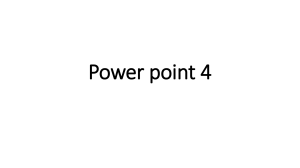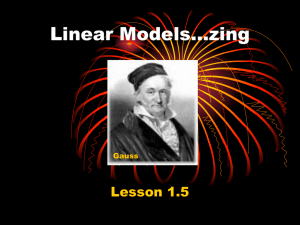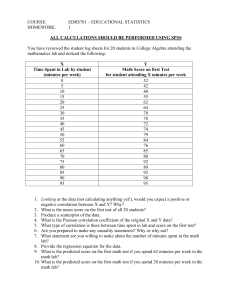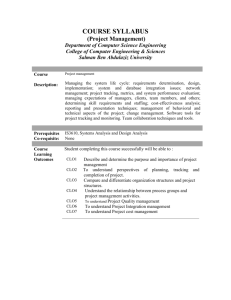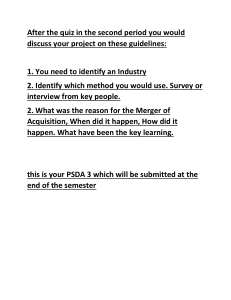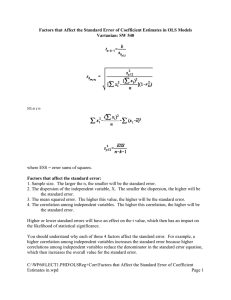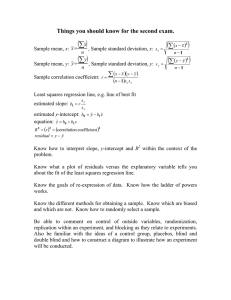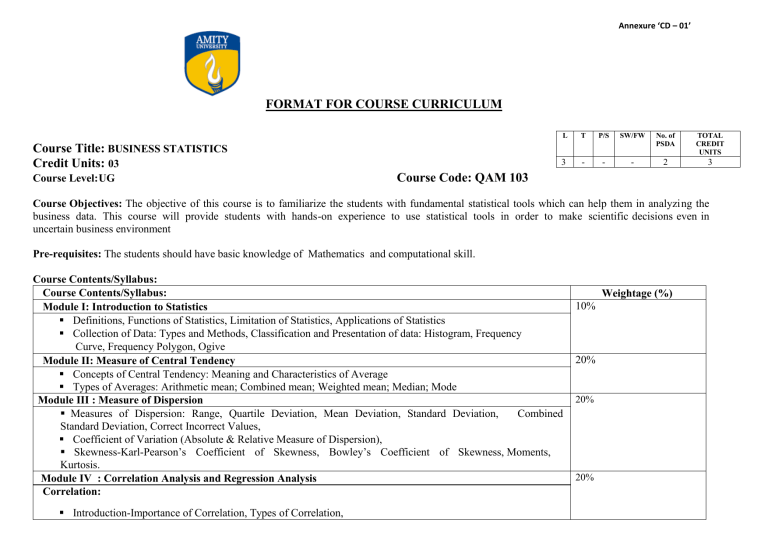
Annexure ‘CD – 01’ FORMAT FOR COURSE CURRICULUM Course Title: BUSINESS STATISTICS Credit Units: 03 Course Level: UG L T P/S SW/FW No. of PSDA TOTAL CREDIT UNITS 3 - - - 2 3 Course Code: QAM 103 Course Objectives: The objective of this course is to familiarize the students with fundamental statistical tools which can help them in analyzing the business data. This course will provide students with hands-on experience to use statistical tools in order to make scientific decisions even in uncertain business environment Pre-requisites: The students should have basic knowledge of Mathematics and computational skill. Course Contents/Syllabus: Course Contents/Syllabus: Module I: Introduction to Statistics ▪ Definitions, Functions of Statistics, Limitation of Statistics, Applications of Statistics ▪ Collection of Data: Types and Methods, Classification and Presentation of data: Histogram, Frequency Curve, Frequency Polygon, Ogive Module II: Measure of Central Tendency ▪ Concepts of Central Tendency: Meaning and Characteristics of Average ▪ Types of Averages: Arithmetic mean; Combined mean; Weighted mean; Median; Mode Module III : Measure of Dispersion ▪ Measures of Dispersion: Range, Quartile Deviation, Mean Deviation, Standard Deviation, Combined Standard Deviation, Correct Incorrect Values, ▪ Coefficient of Variation (Absolute & Relative Measure of Dispersion), ▪ Skewness-Karl-Pearson’s Coefficient of Skewness, Bowley’s Coefficient of Skewness, Moments, Kurtosis. Module IV : Correlation Analysis and Regression Analysis Correlation: ▪ Introduction-Importance of Correlation, Types of Correlation, Weightage (%) 10% 20% 20% 20% ▪ Scatter Diagram Method, ▪ Karl Pearson’s coefficient of Correlation (Grouped and Ungrouped), ▪ Spearman’s Coefficient of Rank Correlation, Rank Correlation for Tied Ranks, Regression Analysis: ▪ Concepts of Regression, Difference b/w Correlation and Regression, ▪ Regression Lines. Regression Coefficient in a bi-variate frequency Module V Time Series Analysis ▪ Introduction; Objectives of Time Series analysis; ▪ Components of a Time Series; ▪ Moving Average Method; method of least squares (fitting of linear trend only) Module V1 Probability Theory and Distributions ▪ Concept; Addition and multiplication theorems of probability; conditional probability & independent events; ▪ Bayes’ theorem; Probability Distribution Function, Binomial distribution; Poisson distribution; Normal distribution and their applications 10% 20% Course Learning Outcomes: On completion of this course the student will be able to: CLO1: Remember fundamental tools and techniques of Descriptive Statistics. CLO2: Understand and identify statistical tools relevant for data summarization, visualization and presentation. CLO3: Apply statistical tools and techniques for developing skill of computation and solving business problems. CLO4: Analyze and interpret result for making effective business decisions. CLO5: Evaluation of uncertainty using probability theory. CLO 6: Create statistical models for forecasting. Mapping of Course learning outcomes (CLOs) with Graduate Attributes (GA) Course Learning Outcomes Graduate Attributes Knowledge and Expertise of Business Analytics Self-directed and Active learning CLO1 CLO2 CLO3 CLO4 CLO5 CLO6 Research and Enquiry Information & Communication Technology Skills Critical thinking and Problem-Solving Abilities Communication Skills Creativity, Innovation & Reflective Thinking Analytical & Decision-Making Ability Leadership & Teamwork Multicultural Understanding & Global Outlook Integrity and Ethics Social & Emotional Skills Employability, Enterprise & Entrepreneurship Pedagogy for Course Delivery: The course pedagogy will include four quadrant approach, discussion on numerical applications, computational practice through Ms-Excel . List of Professional Skill Development Activities (PSDA): i. Presentation of a secondary data by various data visualization tool using Ms Excel and interpretation. ii. Term paper on application of statistical tools to describe any secondary data and interpret the result. Assessment/ Examination Scheme: Theory L/T (%) 100 Theory Assessment (L&T): Lab/Practical/Studio (%) Components (Drop down) Mid Term Exam Linkage of PSDA with Internal Assessment Component, if any Weightage (%) Continuous Assessment/Internal Assessment (50 %) Home Assignment Presentation Term Paper 15 PSDA1 PSDA2 10 10 10 Mapping Continuous Evaluationcomponents/PSDA with CLOs Bloom’s Level > Course Learning Outcomes Assessment type/PSDA Mid Term Exam Home Assignment Presentation(PSDA1) Term Paper(PSDA2) Remembering CLO1 Understanding CLO2 ✓ ✓ ✓ ✓ ✓ ✓ ✓ Applying Analysing Evaluating Creating CLO3 CLO4 CLO5 CLO 6 ✓ ✓ ✓ ✓ ✓ ✓ ✓ ✓ ✓ ✓ Text Reading: • Sharma J K (2014), Fundamentals of Business Statistics, Vikas Pub. House 2. Gupta S P (2013), Statistical Methods, S. Chand & Co. • Kapoor & Sancheti,(2011), Business Statistics, Sultan Chand & Sons References: • Anderson Sweeney Williams(2010), Statistics for Business and Economics, Eighth edition, Thomson • Rubin & Levin (2013), Statistics for Management, Seventh edition, Pearson, Prentice Hall of India. Any other Study Material: • Levine D.M.,David F. Stephan,Kathryn A. Szabat( 2017), Statistics for Managers Using Microsoft Excel, Eighth edition, Pearson End Term Examination (50%) Attendance 5 50
